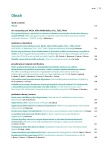-
Medical journals
- Career
Primary hyperaldosteronism: problems of diagnostic approaches
Authors: Jiří Widimský Jr
Authors‘ workplace: Centrum pro hypertenzi III. interní kliniky 1. LF UK a VFN Praha, přednosta prof. MUDr. Štěpán Svačina, DrSc., MBA
Published in: Vnitř Lék 2015; 61(5): 480-483
Category: Reviews
Overview
Primary hyperaldosteronism (PH) is common cause of endocrine/secondary hypertension with autonomous aldosterone overproduction by adrenal cortex. PH is typically characterized by hypertension, hypokalemia, high plasma aldosterone/renin ratio, high aldosterone, suppressed renin and nonsupressibilty of aldosterone during confirmatory tests. Diagnosis of PH can be difficult since hypokalemia is found only in 50 % of cases and measurement of the parameters of renin-angiotensin-aldosterone system can be influenced by several factors. Morphological diagnosis requires in majority of cases adrenal venous sampling. Early diagnostic and therapeutic measures are very important due to high prevalence of PH and potential cure. Patients with suspicion to PH should be investigated in experienced hypertensive centers due to relatively difficult laboratory and morphological diagnostic approaches.
Key words:
diagnosis – hypertension – primary hyperaldosteronism
Sources
1. Conn JW. Part I. Painting background. Part II. Primary aldosteronism, a new clinical syndrome, 1954. J Lab Clin Med 1990; 116(2):253–267.
2. Litynski M. Nadcisnienie tetnicze wyvolane guzami korowo-nad-nerczowymi. Pol Tyg Lek (Wars) 1953; 8(6): 204–208.
3. Funder JW, Carey RM, Fardella C et al. Case detection, diagnosis and treatment of patients with primary aldosteronism: An Endocrine Society Clinical Practice Guideline. J Clin Endocrinol Metab 2008; 93(9): 3266–3281.
4. Štrauch B, Zelinka T, Widimský J Jr et al. Prevalence of primary hyperaldosteronism in middle Europe region. J Hum Hypertens 2003; 17(5): 349–352.
5. Widimský J Jr. Primární hyperaldosteronismus: epidemie anebo jen častá příčina sekundární hypertenze? Cor et Vasa 2008; 50(10): 366–367.
6. Rossi GP, Bernini G, Caliumi C et al. A Prospective Study of the Prevalence of Primary Aldosteronism in 1,125 Hypertensive Patients. J Am Coll Cardiol 2006; 48(11): 2293–2300.
7. Rossi GP, Barisa M, Belfiore A et al. PAPY study Investigators. The aldosterone-renin ratio based on the plasma renin activity and the direct renin assay for diagnosing aldosterone-producing adenoma. J Hypertens 2010; 28(9): 1892–1899.
8. Solar M, Malirova E, Ballon M et al. Confirmatory testing in primary aldosteronism: extensive medication switching is not needed in all patients. Eur J Endocrinol 2012; 166(4): 679–686.
9. Kaplan NM. Clinical Hypertension. 10th ed. Lippincott Williams & Wilkins: Philadelphia 2009. ISBN-13 : 000–1605475033. ISBN-10 : 1605475033.
10. Tanabe A, Naruse M, Takagi S et al. Variability in the renin/aldosterone profile under random and standardized sampling conditions in primary aldosteronism. J Clin Endocrinol Metab 2003; 88(6): 2489–2494.
11. Oelkers W, Diederich S, Bahr V. Primary hyperaldosteronism without suppressed renin due to secondary hypertensive kidney damage. J Clin Endocrinol Metab 2000; 85(9): 3266–3270.
12. Mattsson C, Young WF Jr. Primary aldosteronism: diagnostic and treatment strategies. Nat Clin Pract Nephrol 2006; 2(4): 198–208.
13. Mulatero P, Milan A, Fallo F et al. Comparison of confirmatory tests for the diagnosis of primary aldosteronism. J Clin Endocrinol Metab 2006; 91(7): 2618–2623.
14. Mansmann G, Lau J, Balk E et al. The clinically inapparent adrenal mass: update in diagnosis and management. Endocr Rev 2004; 25(2): 309–340.
15. Rossi GP, Auchus RJ, Brown M et al. An expert consensus statement on use of adrenal vein sampling for the subtyping of primary aldosteronism. Hypertension 2014; 63(1): 151–160.
16. Monticone S, Viola A, Rossato D et al. Adrenal vein sampling in primary aldosteronism: towards a standardised protocol. Lancet Diabetes Endocrinol 2015; 3(4): 296–303. Dostupné z DOI: <http://dx.doi.org/10.1016/S2213–8587(14)70069–5>.
17. Burton TJ, Mackenzie IS, Balan K et al. Evaluation of the sensitivity and specificity of 11C-metomidate positron emission tomography (PET)-CT for lateralizing aldosterone secretion by conn’s adenomas. J Clin Endocrinol Metab 2012; 97(1): 100–109.
Labels
Diabetology Endocrinology Internal medicine
Article was published inInternal Medicine

2015 Issue 5-
All articles in this issue
- Effect of spironolactone in patients with heart failure and preserved left ventricular function – TOPCAT study
- New version of classification of pulmonary hypertension
- Hypertension in females
- The effect of adding phytosterol to hypolipidemic therapy with statins on the size of lipoprotein particles in patients with very high cardiovascular risk
- White-coat hypertension and masked hypertension
- Personalized pharmacotherapy of digoxin
- Controversies accumulated around betablockers
- Is there a need to treat atrial fibrillation aggressively?
- The role of uric acid and allopurinol therapy in cardiovascular disease
- Outpatient treatment of venous thromboembolic disease
- The current state and future of care of patients with congenital heart defects
- Inhibition of renin-angiotensin-aldosterone system in heart failure, or from CONSENSUS to PARADIGM-HF
- Hemocoagulation – New views on the old cascade
- Primary hyperaldosteronism: problems of diagnostic approaches
- Neuro-cardiology or cardio-neurology – a new specialization of the future?
- Pheochromocytoma – why is its early diagnosis so important for patient?
- In what extend we can reach the current LDL-cholesterol treatment goals in secondary prevention
- What may cause diabetes
- Hyperosmolar hyperglycemic state
- Combination treatment of hypertension in 2015
- Internal Medicine
- Journal archive
- Current issue
- Online only
- About the journal
Most read in this issue- Hyperosmolar hyperglycemic state
- Hemocoagulation – New views on the old cascade
- The role of uric acid and allopurinol therapy in cardiovascular disease
- Hypertension in females
Login#ADS_BOTTOM_SCRIPTS#Forgotten passwordEnter the email address that you registered with. We will send you instructions on how to set a new password.
- Career

